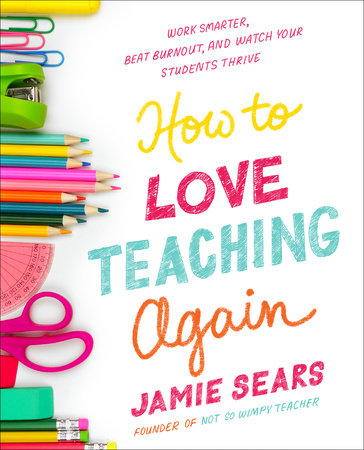
A heartfelt, hands-on guide to setting boundaries, increasing productivity, and finding fulfillment for teachers who know that their classrooms won’t thrive unless they do. As the CEO of Not So Wimpy Teacher, one of the most popular teaching resource brands on the internet, Jamie Sears has spent years designing tools and creating systems that restore the joys of teaching. Her new book, How to Love Teaching Again, offers simple step-by-step strategies that have helped thousands of teachers around the country simplify teaching and set boundaries to transform their relationship with work. Below, Jamie shares why she wrote this book and how she’s using it to launch a serious conversation about education.
I have dreamed of being an author ever since I was a little girl. During recess, I would sit on the wall with my thesaurus, notebook, and pen, not because I was in trouble but because I just loved writing stories.
Back then, I never dreamed that the book I would one day write would be so important, so necessary, and have the potential to impact so many people. But that’s exactly what I hope How to Love Teaching Again will do.
I wrote How to Love Teaching Again for teachers–for people who have spent their entire lives dreaming about being a teacher–about inspiring light bulb moments, mentoring children, and touching lives.
Unfortunately, these same vivacious people are now sitting at their desks in tears. They don’t feel respect from parents or students, or society. They are overworked and overwhelmed. They have way too much on their plates. They look at their massive to-do lists and feel like no matter what they do it will never be enough. Teaching is nothing like they thought it would be.
Sadly, but not surprisingly, these incredibly passionate, highly-qualified educators faced with a sea of unreasonable and unachievable expectations are opting out of teaching. They are leaving the classroom in droves and giving up the only job they ever wanted in favor of other professions.
This breaks my heart. I hate to see teachers who want to teach feel like they have failed and give up on their dreams. So I wrote this book for them. How to Love Teaching Again is packed with many practical, time-saving tips and mindset shifts to help teachers simplify teaching and set boundaries so they can stay in the classroom and be amazing teachers and go home on time.
But that’s not enough. We are at a crisis point in education. The best educators are leaving the classroom faster than they can be replaced. Unless something fundamental changes in the way we treat teachers and prioritize education, our children will suffer.
My hope is that this book will be a catalyst for change. I am on a mission to educate society and decision-makers about what it’s really like to be a teacher today. I want to raise awareness about what’s happening behind classroom doors and to start a conversation about how we–teachers, parents, students, administrators, the government, the media, all of us–can change that and make it better.
How to Love Teaching Again absolutely will help a teacher become a little less frazzled and more productive and redefine what it means to be a “good teacher.” But it must also be the beginning of a much needed conversation about the state of education in America today. We owe it to our children.






